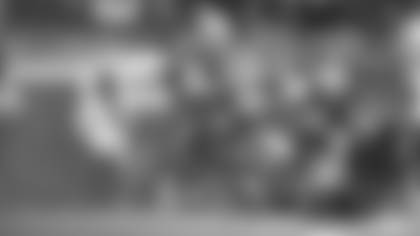The Patriots are heading to the West Coast for a matchup with the defending NFC Champions, and Sunday's game vs. the 49ers is all about identity.
Although they're massive underdogs in San Francisco, head coach Jerod Mayo's team must return to their winning formula. Nobody should expect a win over the 49ers, who are 10.5-point favorites despite catching the injury bug, but it needs to be more competitive than a 24-3 letdown in the Meadowland last week. In their first two games, the Patriots beat a favored Bengals team and took the Seahawks to overtime by being a team with a run-first offense and a strong defense. It was old-school football. It had a ceiling, but it was working, and it's really the only path to victory for the time being in New England.
Last week, offensive coordinator Alex Van Pelt tried to flip the script on the Jets, starting with a play-action pass plan rather than committing to the run game. After running the ball well in their first two games, Van Pelt expected the Jets to load up to stop the run, opening up opportunities to throw the ball downfield. The Patriots only ran the ball two times in the first quarter compared to seven pass attempts, with the idea being they'd get back to the run game after the defense adjusted to the pass.
"We thought that we earned the right to be able to push the ball down the field," Van Pelt explained. "We're trying to find more explosives in our pass game, and that comes through the run and the run action. That was the thought process going in. Again, in hindsight, I'd probably run it a little bit more early," Van Pelt told reporters last Friday.
Unfortunately, the Pats never got back to the run game because the score got out of hand. Mainly, the pass-first plan failed because New England's pass protection didn't hold up well enough for QB Jacoby Brissett to attack downfield, so the Patriots quickly fell behind.
Although this week is about reestablishing the line of scrimmage offensively, you also can't ignore that the defense hasn't held up its end of the bargain either. To be competitive this season, the Patriots defense needs to drive the bus, as it did in their Week 1 win. New England should be ahead of schedule defensively, but the Patriots defense is 27th DVOA, which is not good enough for this team to keep its head above water.
Before we discuss any X's and O's, it must be said that the Patriots cannot afford an identity crisis: they can't play the way they did last week and expect to compete. Therefore, more so than the final score against a loaded Niners team, reestablishing their identity is imperative.
Without further ado, here's a preview of what to expect on both sides of the ball and key matchups in the Patriots showdown against the 49ers in Santa Clara on Sunday:
Patriots Defense vs. 49ers Offense: Using the Brian Flores Blueprint to Slow Down Niners
The only way the Patriots play winning football moving forward is by getting their defense in order, so let's start with a tough matchup vs. Kyle Shanahan's offense on Sunday.
As many of you know, this scribe has long been an admirer of Shanahan's due to his excellent play design and sequencing, which makes San Francisco one of the toughest offenses to defend in the NFL. Despite injuries to key playmakers Christian McCaffrey, Deebo Samuel, and George Kittle, the 49ers still scored 24 points last week, with Purdy adding +0.42 expected points per drop-back (90th percentile) without most of his go-target receivers in a loss to the Rams.
The hallmarks of Shanahan's offense are heavy personnel usage, an outside zone run game with play-action boots off it, and condensed formations with heavy amounts of pre-snap motion. According to NextGen Stats, the 49ers use 11-personnel at the fourth-lowest clip in the league (40.6%), basing their offense out of a two-back personnel package where Swiss-army knife Kyle Juszczyk can blur the lines between different groupings. San Francisco also has the most condensed average formation width in the NFL (19.4 yards), the fourth-highest rate of plays under center (45%), and utilizes motion on 81.6% of their offensive plays (fourth-highest in the NFL).
My biggest worry in this game is the Patriots run defense vs. the 49ers rushing attack because San Francisco can stretch the Pats bigger front seven horizontally with excellent team speed. Everything the 49ers do is built off their outside zone rushing attack, so it starts up front, per usual.
Outside zone is when blockers step horizontally toward the sideline to stretch out the defense. Then, the back can either win the foot race to the edge or cut runs back through the middle of the field. The Niners outside zone often results in a cutback, where San Francisco creates huge rushing lanes for new lead-back Jordan Mason. Check out this clip where Mason cuts back behind All-Pro left tackle Trent Williams, who pancakes his guy into the ground on a big gain (hell, yeah).
From there, the 49ers have two ways to beat you through the air: play-action and cans. With play-action, Shanahan takes the horizontal stretch off outside zone to vertically stretch early-down zone coverages. Above, the Niners are running their "bottle" concept where they pair a blaze out with a search route over the middle, and the receiver settles in the zone void.
However, San Fran isn't running play-action at as high a clip as years past, with the fifth-lowest play-action rate in the league (16.5%). Instead, Purdy has a "can" system where he can pick a run or pass play based on the pre-snap coverage shell. Shanahan will use pre-snap shifts to give Purdy coverage indicators at the line to check them into the right play.
Here, the coverage shell declares as a post-safety zone structure with Juszczyk's shift as a tell. Purdy goes from under center to run a C.O. (corner-out) concept that high-lows the outside corner to the field, and Purdy makes the easy throw for an explosive.
Now that we've established the staple concepts for the 49ers offense, the question is how does the Patriots defense stop it? Although that's easier said than done, old friend Brian Flores gave New England's coaching staff a blueprint in a Week 2 win. Minnesota held the Niners to 17 points with two turnovers and -0.02 expected points added per drop-back for Purdy.
The first key to Flores's game plan came from the Patriots plan in Super Bowl 53 to slow down the 49ers-adjacent Rams offense under head coach Sean McVay. Flores played five and six-man fronts on early downs to give the Vikings the edge support to stop outside zone. By sometimes putting six defenders on the line, Minnesota gave its interior defenders the freedom to get vertically upfield. Vertical penetration is death for the outside zone scheme, with Flores's strategy holding the 49ers to -0.17 expected points added per rush.
In the passing game, Flores changed the picture with post-snap rotations. As mentioned, Purdy often decides at the line of scrimmage whether the 49ers are going to run or pass based on the defense's structure. So, Flores messed with his pre-snap reads by disguising coverage.
In this play, Purdy thought he had a post-safety coverage, so he dropped back from under center. The 49ers are running another staple with mirrored dig routes. Purdy opens to the right, thinking he has a cover-three corner playing off-coverage, meaning the in-cut should be open. Instead, the Vikings drop into a quarters scheme, bracketing the dig route to Purdy's right. He then throws the "arrow" route late over the middle, and it's intercepted.
With the early-down defense doing its thing to put the 49ers in third down, that's when Flores brought out his exotics. Above, the Vikings show cover zero before the snap and then drop the interior rushers into a cover-two zone. The pass-rush disguise gets one-on-ones up front for Minnesota's rushers, and Purdy, who doesn't have the biggest arm, tries to split the safeties by throwing off his back foot from a condensed pocket to no avail.
Although the Patriots overall execution defensively must improve, the system Flores is running in Minnesota has a lot of overlap with New England's defensive scheme. Coach Mayo and defensive coordinator DeMarcus Covington can emulate Flores' schemes to fluster Purdy. However, it all starts up front with stopping the run, which was an issue against a similar Jets run game without captain Ja'Whaun Bentley at linebacker.
San Francisco's offense is as big a test as the Patriots defense will face this season. It's not a great matchup for New England to get right, but that's life in the NFL.
Patriots Offense vs. 49ers Defense: Browns/Rams Outlined Path for New England
Moving over to the offense, it goes without saying that the Patriots need to worry about their own house to a degree before we even begin discussing game-planning an opponent.
That said, you don't go into a game throwing your hands up while saying, "Well, we can't do anything offensively, so what's the point?" New England still needs a plan it believes it can execute against a 49ers defense in a transition period. San Francisco ranks 21st in DVOA on defense after finishing fourth a year ago under former DC Steve Wilks. Shanahan fired Wilks after the Super Bowl due to philosophical differences, promoting Nick Sorensen to defensive coordinator, with former Chargers head coach Brandon Staley also helping out (assistant head coach/defense). Before joining the 49ers, Sorensen cut his teeth in the NFL on Pete Carroll's staff with the Seahawks, so he is well-versed in the Seattle-3 scheme.
The bones are still the modern version of the Seattle-3 (Cover-3/quarters) with a four-man rush, but the Niners are playing more man coverage under Sorensen. Sorensen has called man coverage at a nine percent higher rate this season compared to 2023, while cover-1 is the most-used 49ers coverage at the eighth-highest rate in the NFL (29.7%). They're still a four down front with the second-highest four-man rush rate without much blitzing (second-highest in NFL), and cover-three/quarters make up 44% of their passing plays.
As for the Patriots best game plan, philosophically, they have to be able to run the ball. Looking back at the Browns win over the 49ers last season with backup QB P.J. Walker, offensive coordinator Alex Van Pelt and head coach Kevin Stefanski utilized gap schemes on two-thirds of their designed runs. The Niners four-down front utilizes wide defensive ends with penetrating defensive tackles, making it difficult to get the edge on outside zone.
Cleveland countered that by running crack toss schemes early in the game to hit outside faster. With Walker at quarterback, the Browns ran a same-side crack toss scheme from the gun to establish an outside run game. Even if the outside runs aren't overly successful for the Patriots offense, it's good to show the defense, so they have to respect the outside run game. The Browns also ran an end around/reverse for an explosive as another way to get outside the tackles.
From there, the Browns started using their duo and trap schemes to get downhill. Above, Cleveland calls an influence trap play to invite an aggressive defensive line upfield and then earhole those upfield defenders with pullers to get the running back a downhill crease.
To transition into the Rams tape, McVay dialed up duo schemes to get double teams on the two interior defenders on the 49ers defensive line. With the wide edges, those A and B-Gaps to the strong side are juicy. You can see how much movement the Rams O-Line gets on duo, opening pathways for their backs to run over the 49ers defense.
Although there's always a pass protection caveat for the Patriots, McVay made the 49ers pay for playing man coverage by putting his playmakers in good spots with formations and motion. Stafford finished the game 5-of-7 for 73 yards and a touchdown vs. man schemes last week.
One thing the Patriots can copy from the Rams is how McVay used speedy receiver Tutu Atwell on crossing routes. In the two clips above, McVay motions Atwell into a three-receiver bunch at the snap, helping Atwell gain leverage and a free release. At that point, it becomes a foot race for Atwell running across the field. With the defense in man-free (no robber help), Atwell outruns the man coverage defender on a shallow and intermediate crosser.
Another way the Rams moved the ball through the air was by targeting 49ers LB De'Vondre Campbell. Campbell is replacing stud LB Dre Greenlaw (PUP) next to Fred Warner while Greenlaw recovers from a torn Achilles he suffered in last year's Super Bowl. Campbell allowed a 15-yard TD (zone) and was called for a key pass interference penalty late in last week's loss.
On the DPI, McVay shifts TE Colby Parkinson out wide before the snap, and the 49ers leave Campbell on an island. Campbell ends up interfering by arriving early to the catch point when the ball was in the air, and it's a 25-yard penalty that sets up the game-winning field goal.
New England could use WR DeMario Douglas (5-8, 180 lbs, 4.44-speed) in a similar fashion the Rams deployed Atwell (5-9. 155 lbs, 4.39-speed), while both of the Pats tight ends could have favorable matchups in man coverage situations. Ultimately, you can't expect much from the Patriots offense until the blocking improves, but those are some ideas for AVP this week.
Key Matchups
LT Caedan Wallace vs. 49ers EDGE Nick Bosa
Here's the mismatch special of the week and a welcome to the NFL matchup for rookie LT Caedan Wallace. Bosa has the eighth-highest PFF grade among edge defenders (87.6) and 12 total pressures through three weeks. His go-to move is a two-hand swipe rush where he can keep himself clean and utilize his excellent first step/bend to turn the corner. The four-time Pro Bowler is a problem, but without DT Javon Hargrave on the interior, the Pats can help Wallace more easily. They'll need chip help and protection slides in Bosa's direction any time they drop-back pass. AVP has to earn his paycheck here. There shouldn't be any circumstances where Wallace is one-on-one with Bosa in an obvious passing situation.
CB Christin Gonzalez vs. 49ers WR Brandon Aiyuk
There's a case for the Patriots to put Gonzalez on breakout WR Jauan Jennings (11 catches, 175 yards, 3 TDs vs. Rams) instead of Aiyuk, who has been quiet. However, Jennings is playing the Deebo role as the Z receiver with a 50-50 split in the slot and out wide. My guess is the Pats have Gonzo shadow Aiyuk while they send brackets/robber help at Jennings. The Pats other corners will be at a size disadvantage against Jennings (6-3, 215), but they'd have the same problem vs. Aiyuk (6-0, 205), and there's a good chance that Gonzalez could take Aiyuk out of the game.
EDGEs Keion White/Anfernee Jennings vs. LT Trent Williams/RT Colton McKivitz
As mentioned, stopping San Francisco's outside zone run game all starts on the edge of the defense. The Pats need to set the edge to let their interior defenders get vertical to shut down stretch runs. Expect the Patriots to roll with their sturdy edge-setters this week to force the ball carrier back inside where the numbers are for the defense. We'll also be watching the pass-rush discipline, which has been a problem for two straight games. Purdy has been extending plays more this season, so it's on the edge rushers to keep him in the pocket. New England needs a bounce-back week from this group.
DISCLAIMER: The views and thoughts expressed in this article are those of the writer and don't necessarily reflect those of the organization. Read Full Disclaimer













































